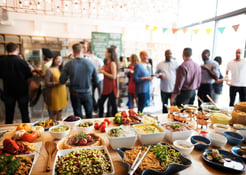It’s a simple equation: A powerful brand equals increased profitability.
In an industry well-known for slim margins, restaurants that succeed are generally those that take every opportunity to strengthen and grow their brand. And there are plenty of cost-effective ways to do so.
We break down eight strategies that you can get started on now.
Own your social media accounts
The average Internet user spends two hours and 25 minutes per day on social media, making it an important marketing tool for any restaurant. Platforms like Instagram and TikTok allow you to engage with current customers, attract new business, and generally promote your restaurant. But creating posts that drive a double take – or a double tap – takes a little finesse, and of course, time.
Key areas to focus on include crafting quality photos (or hiring someone to do it for you), keeping a consistent voice across all platforms, and actively responding to customers’ comments to engage your community. Take advantage of this space to share your restaurant’s story and its top highlights. And remember to post consistently. After all, social media is essentially free advertising, and that’s not an opportunity to miss.
Leverage influencers
Social media “influencers” help brands reach newer, and larger audiences, serving as a tool to draw in new customers. Those that specialize in restaurants are generally exceptionally talented at making food shine in front of a camera, too. Every photo they post gives you an opportunity to re-share and add new content to your own platform – typically for an affordable price.
While some influencers charge a fee per hosted meal, others work solely in exchange for free food and drinks. Be sure to address all posting and payment expectations upfront, and look for influencers with engaged followings local to your area. For more influencer tips, click here.
Start an active loyalty program
It’s easy to see why so many restaurants are launching loyalty programs. (Fifty-seven-percent of restaurants now have a loyalty program, according to one estimate.) A successful loyalty program keeps customers coming back, again and again. Plus, it’s an effective way to increase revenue. When a brand establishes a positive emotional connection through its loyalty program, nearly 30-percent of members say they spend more with the brand, according to a Bond report sampling 55,000 consumers.
Loyalty programs are now often more economical than ever, too, shifting away from one-size-fits-all, discount-style rewards in favor of personalized, experience-based incentives (i.e., a “members-only” menu, VIP access to jump the line, etc.). Plus, loyalty programs gain you closer access to your best customers. The data you collect can be used to make sure you’re meeting your top customers’ needs so that you retain their business for the long run, and it’s easy when you partner with a technology platform.
Optimize your business on Google
As a brick-and-mortar business, you're nowhere until you're on Google Maps. More than a billion people per month use the platform, including plenty who are in search of a good place to eat. This makes it incredibly important to ensure that Google Maps knows where to find you – a process that’s free.
Learn how to leverage local SEO and optimize your Google business profile for success, here.
Leverage your email database
A simple email address may be your best tool for converting a casual visitor into a restaurant regular. And likely you’ve gathered hundreds, maybe thousands, of those email addresses already through your POS.
You can use that contact list to your advantage to market restaurant highlights, like special events and new menu launches, and to routinely remind customers to pay a visit. But the most effective email marketing happens through segmenting customers into categories. This enables you to personalize messaging to drive specific behavior and better engage customers. For more tips on how to bring your email database to life, click here.
Build a collection of professional food photographs
Between delivery apps, your website, social media, and press opportunities, high-quality photos are a huge asset for every restaurant. And it’s why it’s worth investing in a photographer to help build a library of images.
You can expect to pay anywhere from $100 to $400 per hour for a photographer, but often that’s a nominal expense when you consider the payoff. This can be significant, especially if your website and delivery platforms are major traffic drivers for your business.
To maximize your investment, take a few steps upfront, like preparing a detailed shot list, asking staff if they’re open to participating (human hands make food come to life!), and discussing possible package deals with the photographer. For more tips, click here.
Partner with other industry brands to create multiple revenue streams
In the past few years, we’ve seen numerous restaurants explore creative and alternative revenue streams, like selling merchandise, groceries, meal kits, and beyond. And while this became a pandemic lifeline for many, the trend is now seen as a smart strategy to stay sustainable in an endlessly challenging industry.
If you, too, want to try your hand in diversifying your business, but aren’t sure where to start, consider partnering with a local brand who’s already selling in the space you want to enter.
To give a picture of what this could look like, consider Philadelphia food entrepreneur Charisse McGill, who grew her French toast business into a six-figure enterprise, largely through teaming up with established local partners. In addition to selling freshly fried, bite-sized cinnamon bites, McGill now sells everything from a French toast ale to a spiced coffee blend to a strawberry French toast gelato.
Test new ideas as virtual restaurants
On track to becoming a trillion-dollar industry by 2030, the ghost kitchen market is booming, attracting many entrepreneurs with the promise of lowering barriers, like labor and overhead, to starting a restaurant.
While ghost kitchens do have their pitfalls – costly reliance on third party delivery platforms, virtual marketing demands, etc. – the outlet gives entrepreneurs time to build a business, plus a fan base, all without a huge upfront commitment.
Some restaurants are allocating space in their existing kitchens to trial new ideas. And this is often a particularly cost effective way to test the market before launching a brick and mortar – or even just to build a separate revenue stream in the virtual sphere. (For a window into what that looks like, read about Nashville-based A. Marshall Hospitality’s virtual restaurant story, here.)
[Photo courtesy Victor Freitas]





